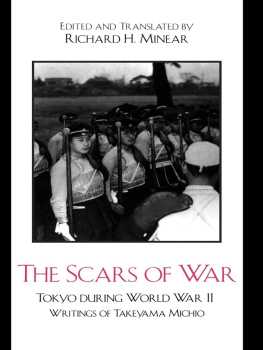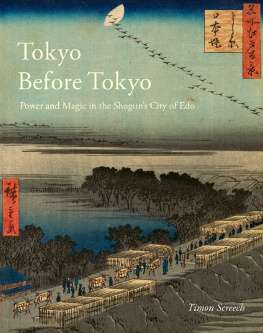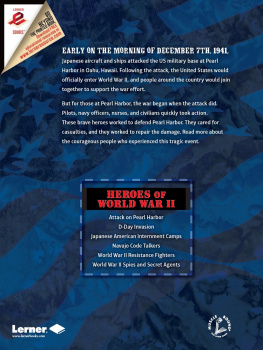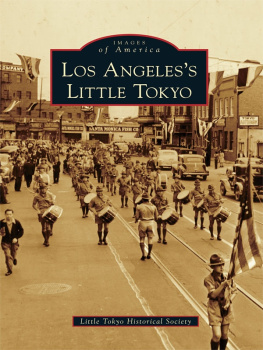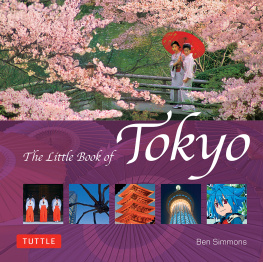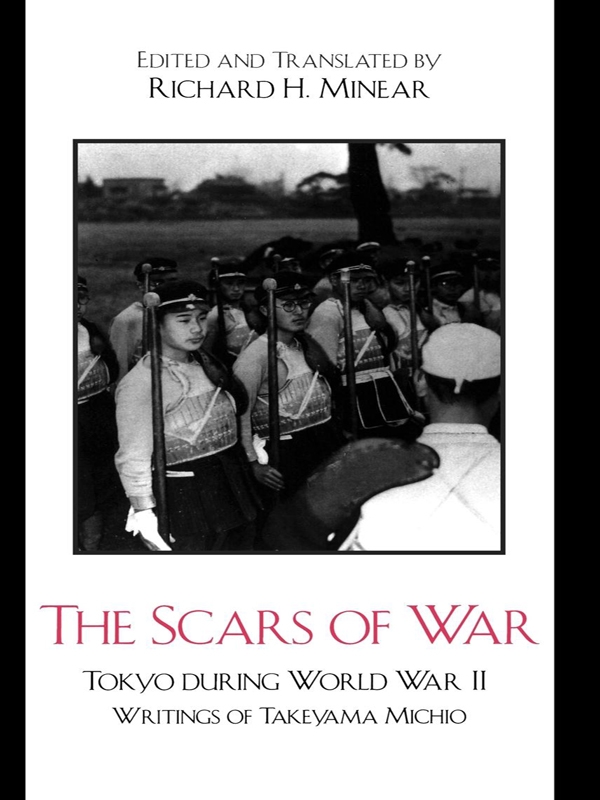Richard H. Minear is professor of history at the University of Massachusetts, Amherst. He is the author of Victors Justice: The Tokyo War Crimes Trial (1971) and Dr. Seuss Goes To War (1999). His translations include Requiem for Battleship Yamato (1985), Hiroshima: Three Witnesses (1990), Black Eggs (1994), and the autobiography of historian Ienaga Sabur, Japans Past, Japans Future: One Historians Odyssey (2001), for Rowman & Littlefield.
Ichik in 1944
Ichik in 1944 details Takeyamas experiences as faculty member and dormitory overseer, both on the Komaba campus and at one of several work sites. It tells of friction between two student cohorts, between the school and its neighbors, and also between the school and the military. It describes students without shoes, students getting called up into the military, students studying despite everything.
Ichik in 1944 appeared in the December 31, 1946, issue of the Ichik bulletin.
1944 was a most difficult year for our school. My memories are vivid, and the year was eventful. Were I to write about it in detail, Id go on forever, so Ill simply note here some things I experienced, material for a page of the schools history.
Since the spring of 1944, second-year students had been working at a factory in Hitachi. To write about the months at Hitachi in detail would make a fascinating tale. Young people being young people, even in hard times they fashioned their own lives. But doing so in those times was completely unacceptable. In particular, in that militarized factory town, Ichik student life itself was defiant and provocative. Sometimes it was taken as insulting.
The Ichik students borrowed a vocational school dorm; the teachers there had often said to their pupils, The Ichik students will arrive soon. Model yourselves on them. But soon after the Ichik students arrived, the teachers stopped staying that. Instead, they warned: Dont ever imitate them!
At night, under complete blackout, the entire city turned dark. Only the Ichik dorm on the hill above the ocean had lights on, unshaded. Seeing this, the townspeople worried. At the time American submarines were already a constant presence fifty miles offshore.
At the factory the students worked hard and earned trust, and they studied hard for the few hours in the day after they returned to the dorm. But to outsiders, the idiosyncrasies of students raised in the Magic Mountain that was Ichik were incomprehensible. Ichik students walked in big groups, singing as they went. That was what drunks or crazy people did. Walking in the rain, they covered themselves from head to toe with their capes. Encountering these weird figures, girls grew frightened and ran away. (During the war, these capes had a symbolic meaning and became the butt of criticism. How many teachers meetings the capes occasioned!)
Hitachi being the sort of town it was, it had its brothel. Go there, and you could buy a meal.
What the people of the town had expected, of course, was that Ichik students above all others would show the way in their absolute faith in victory. To reassure people that this was not false, an illusion, the students would have learned to follow to the letter the behavior the times called for: clothes, rules, salutes, and the like. They of all people would always sing out, Draw the sword that slays evil and carry on unchanged the tradition of resistance to the siren call of the West.
But Ichik students maintained neither this illusion nor this behavior. Nor was that all: by a strange irony of the changing times, the very spirit that in the old days opposed liberalism had now become a defender of liberalism. Here for better or worse was an ingrained idealism, and it whispered, Dont follow fashion blindly. The esprit dcorps that always develops when one sort of people of the same age gather in one place, and their agetwenty or thereaboutsproduced here a special spirit. It was a pure idealism, seeing everything conceptually, and a related lack of concern with reality.
Leaving their own world behind, these young people came here to work in a weapons arsenal. And this is what they saw.
For example, when, at the ringing of a handbell, they enter the cafeteria, they find several hundred vocational school pupils sitting there. Up front is one aluminum bowl, and each waits with his own lunch box for lunch to be given him. The pupils range widely in age, some of them already adult in appearance, some still childish. Their expressions are uniformly empty and horribly docile. Ask them the sum of three plus four, and some of them would count on the fingers of both hands, so every stage of the meal, too, takes place on command.
There is a large Shinto altar high in front and here, on a step below it, epaulettes on their shoulders, the supervisors are lined up. All through the meal, supervisors walk about, keeping watch.
On command, the entire hall stands, bows to the altar, and observes a moment of silence. On command, they sit back down, and the several hundred recite in unison. Ancient words of ritual blessing, they express gratitude for the meal and for the good fortune of prosperity under the emperors reign; the Ichik students call it an incantation.
When this is over, again on command, one squad leader per table stands up. In sequence, the pupils raise their lunch boxes high and incline their heads. The squad leader then takes these boxes and dishes up the food. Thus begins the meager meal.
The Ichik tables were in a long line under the windows. If the Ichik students did not arrive on time, they neither bowed nor recited the incantation. For the vocational school, control via regimentation was a practical necessity, so the cafeteria observances became a fractious issue. But days passed without any solution being arrived at, and finally a cold, tough atmosphere of callousness between them and us became the solution.
As I ate on the high step, I often thought I had seen it before, as a prison scene in a movie.
This cavalier attitude on the part of Ichik students was a cause of worry for the teachers who had accompanied them. We made excuses and apologized to the townspeople; we scolded and pleaded with the students. A thing of no consequence as far as intent was concerned gave rise to fearsome misunderstanding; it was looked at askance, as an outrageous lack of common sense or as evidence that in essence Ichik students didnt support national policy.
This last point was particularly tricky. Insist on pursuing it, and there were things for which we had no response. During the war, we lived a strange contradiction.
Our shaky position was as follows. That the country lose the war and fall to ruins was of course not something we desired. Yet we couldnt bring ourselves to hope that those now ruling us should win. But as of now they were the country. There was no way to change that. To separate leaders from country and topple them ourselves was inconceivable. Modern organization and weaponsthey were destiny, pure and simple.
The emissary this destiny sent to Ichik was a man with three stars on his shoulder, a short moustache, and a simple heart. He tried to insert into official documents the words, School is a branch of the military, but he encountered the opposition of the head teacher and, after heated words, backed off for a time. Further, he asserted that the proper way to salute was not to remove ones hat but to touch ones hat, and again he encountered opposition. Whether one saluted by touching ones hat became an index of whether Ichik itself intended to obey the military.

